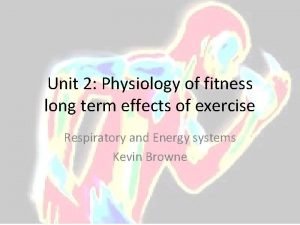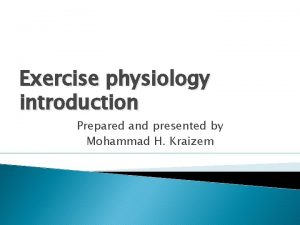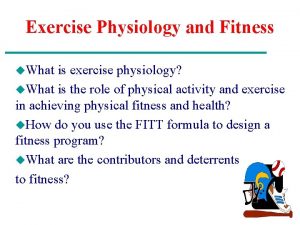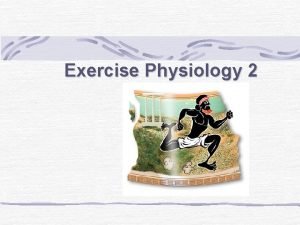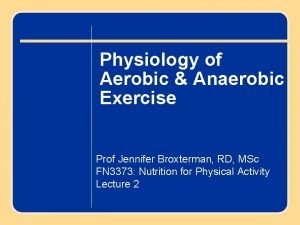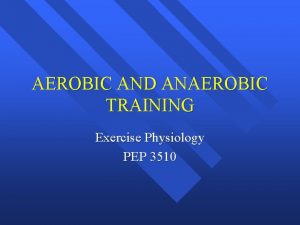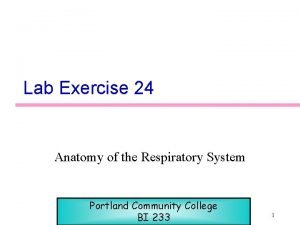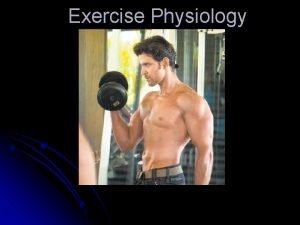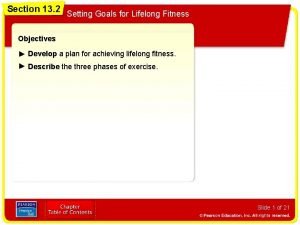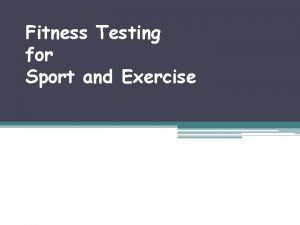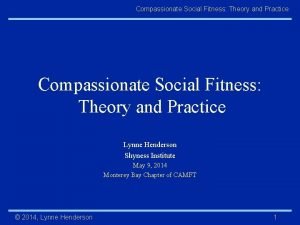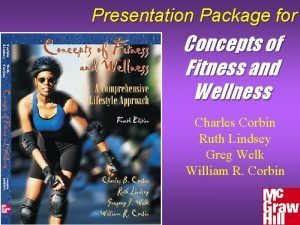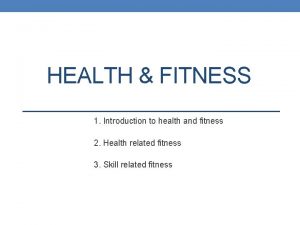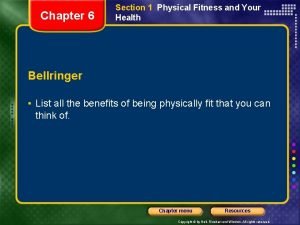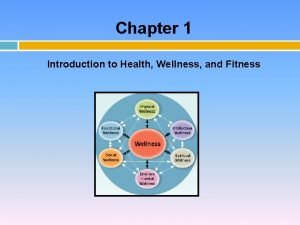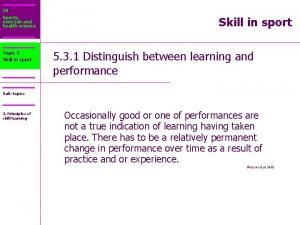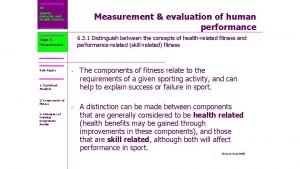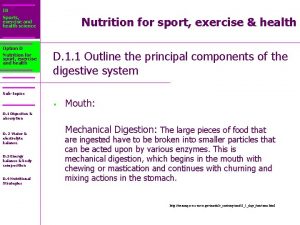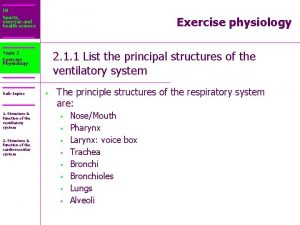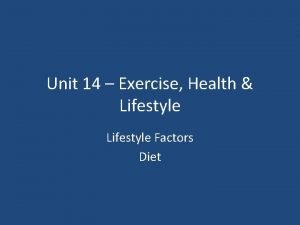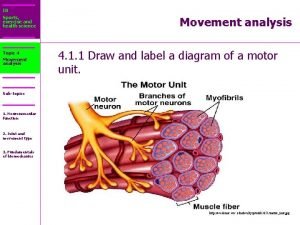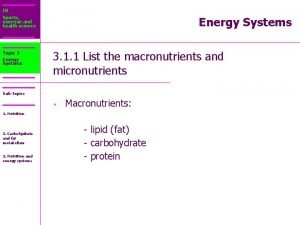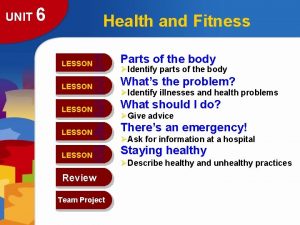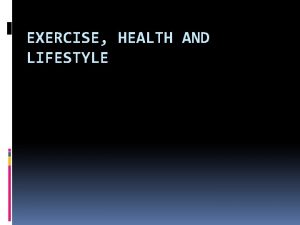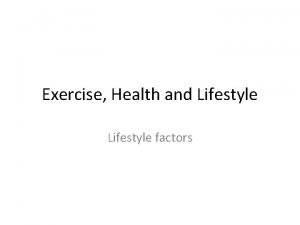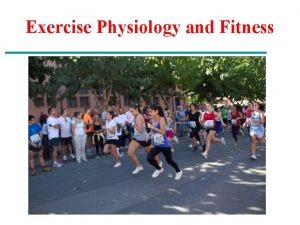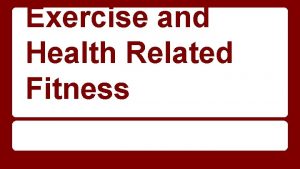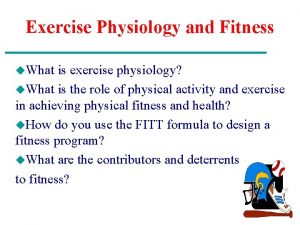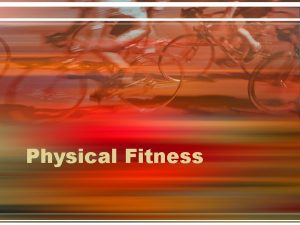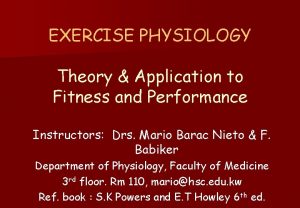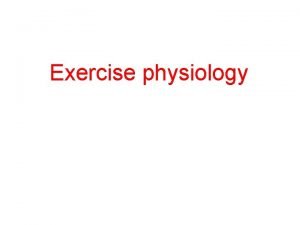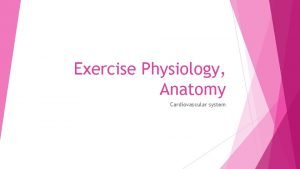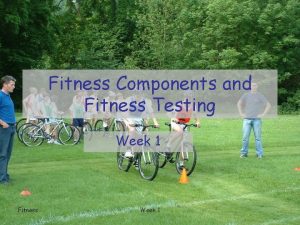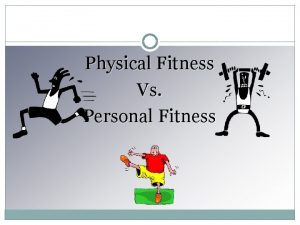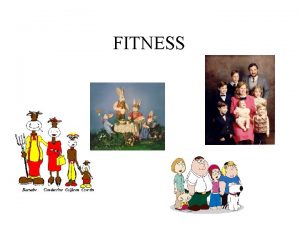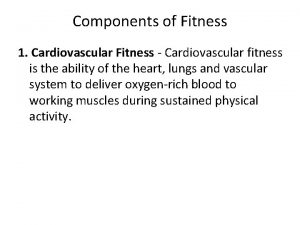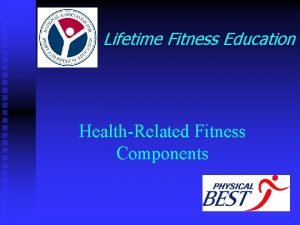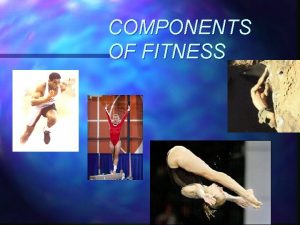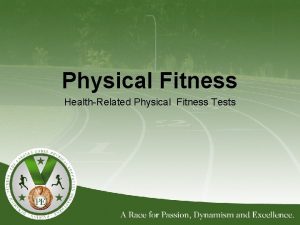Exercise Physiology for Health Fitness and Performance Fifth


































- Slides: 34

Exercise Physiology for Health, Fitness, and Performance Fifth Edition Chapter 8: Body Composition and Weight Control Denise L. Smith • Sharon A. Plowman Copyright © 2018 Wolters Kluwer Health | Lippincott Williams & Wilkins

I. The Caloric Balance Equation Kilocalorie—The amount of heat needed to raise the temperature of 1 kg of water by 1°C Caloric Balance Equation—The mathematical summation of the caloric intake (+) and energy expenditure (−) from all sources Copyright © 2018 Wolters Kluwer • All Rights Reserved

I. The Caloric Balance Equation (cont. ) Caloric Balance = + food ingested (kcal) − basal or resting metabolic rate (kcal) − thermogenesis (kcal) − work or exercise metabolism (kcal) − energy excreted in waste products (kcal) Copyright © 2018 Wolters Kluwer • All Rights Reserved

Caloric Balance Copyright © 2018 Wolters Kluwer • All Rights Reserved

Energy Expenditure Copyright © 2018 Wolters Kluwer • All Rights Reserved

Appetite Control Copyright © 2018 Wolters Kluwer • All Rights Reserved

The next section details the effect of 1) diet, 2) exercise, and 3) exercise training on the components of the caloric balance equation: A. Food intake (kcal) B. Basal or resting metabolic rate (kcal) C. Thermogenesis (kcal) D. Work or exercise metabolism (kcal) E. Energy excreted in waste products (kcal) Copyright © 2018 Wolters Kluwer • All Rights Reserved

Overview of How Section Is Organized Components of Caloric Balance Equation Diet Exercise (acute) Food Intake BMR Thermogenesis Exercise/activity/work energy expenditure Energy expended in waste Copyright © 2018 Wolters Kluwer • All Rights Reserved Exercise Training

Food Intake 1. Impact of diet on food intake 2. Impact of exercise on appetite and food intake − No clear evidence for a transient reduction or increase in food intake following exercise bout Copyright © 2018 Wolters Kluwer • All Rights Reserved

Food Intake (cont. ) 3. Impact of exercise training on appetite and food intake − Active individuals consume more calories than sedentary individuals − Energy intake increases (highly trained and lean) or remains unchanged as a result of training (untrained and obese) − When training ceases, energy intake is spontaneously reduced Copyright © 2018 Wolters Kluwer • All Rights Reserved

Resting or Basal Metabolism ● Basal Metabolic Rate—The level of energy required to sustain the body’s vital functions in the waking state, when the individual is in a fasted condition, at normal body and room temperature, and without psychological stress ● Resting Metabolic Rate—The energy expended while an individual is resting quietly in a supine position Copyright © 2018 Wolters Kluwer • All Rights Reserved

Standard Basal Metabolic Rate across the Age Span Copyright © 2018 Wolters Kluwer • All Rights Reserved

Resting or Basal Metabolism (cont. ) 1. The impact of diet on resting metabolic rate − Severe caloric restriction decreases RMR Copyright © 2018 Wolters Kluwer • All Rights Reserved

Resting or Basal Metabolism (cont. ) 2. The impact of exercise on resting metabolic rate - Transient increase - EPOC - A lot of speculation, but little clear evidence that an exercise bout changes RMR Copyright © 2018 Wolters Kluwer • All Rights Reserved

Resting or Basal Metabolism (cont. ) 3. The impact of exercise training on resting metabolic rate - Research is inconclusive. - RMR is related to muscle mass. Copyright © 2018 Wolters Kluwer • All Rights Reserved

Thermogenesis—The production of heat 1. The impact of diet on thermic effect of a meal 2. The impact of exercise on thermic effect of a meal 3. The impact of exercise training on thermic effect of a meal Copyright © 2018 Wolters Kluwer • All Rights Reserved

Exercise/Activity Energy Expenditure ● Diet does not affect energy expenditure with exercise ● Obviously, exercise increases exercise energy expenditure Copyright © 2018 Wolters Kluwer • All Rights Reserved

Summary Copyright © 2018 Wolters Kluwer • All Rights Reserved

II. The Effect of Diet, Exercise Training, and Diet Plus Exercise Training on BC and Weight Physiological Goals 1. To lose body fat with special consideration to visceral abdominal fat 2. To preserve fat-free weight 3. To maintain or improve health 4. To maintain or improve performance in athletes Copyright © 2018 Wolters Kluwer • All Rights Reserved

Check Your Comprehension Copyright © 2018 Wolters Kluwer • All Rights Reserved

Behavioral Compensation during Exercise Training and Individual Fat Loss Copyright © 2018 Wolters Kluwer • All Rights Reserved

Body Composition and Anthropometric Changes in Response to Aerobic Exercise Training in Overweight/Obese Males and Females Copyright © 2018 Wolters Kluwer • All Rights Reserved

Average Percent Body Fat of Male and Female Athletes (17– 35 Years) in Selected Sports Copyright © 2018 Wolters Kluwer • All Rights Reserved

The Effects of Diet Plus Exercise Training on Body Composition and Weight Copyright © 2018 Wolters Kluwer • All Rights Reserved

The Effects of Diet, Exercise, and Diet Plus Exercise on Abdominal Obesity ● Significant relationship between aerobic exercise training and visceral fat reduction ● That although visceral fat reduction is significantly related to weight reduction during the aerobic exercise training, a significant reduction in visceral fat can occur without significant weight loss ● Dose-response relationship between the amount of aerobic exercise and the amount of visceral fat reduction Copyright © 2018 Wolters Kluwer • All Rights Reserved

The Effect of Caloric Restriction with or without Exercise on Fat Loss Copyright © 2018 Wolters Kluwer • All Rights Reserved

III. Application of TP for Weight and Body Composition Loss and/or Control A. Specificity - Diet plus exercise is recommended - Goal is caloric deficit of 3, 500– 7, 000 kcal per week (500– 1, 000 per day) in order to loss 1 -2 lb per week 1. Weight loss 2. Spot reductions 3. Prevent weight gain Copyright © 2018 Wolters Kluwer • All Rights Reserved

Copyright © 2018 Wolters Kluwer • All Rights Reserved

III. Application of TP for Weight and Body Composition Loss and/or Control (cont. ) B. Overload - Defined as net caloric deficit - Burning large number of calories is most beneficial, for many people this requires low- to moderateintensity activity that is maintained for a long duration - 300 kcal per session, 3 days per wk Copyright © 2018 Wolters Kluwer • All Rights Reserved

III. Application of TP for Weight and Body Composition Loss and/or Control (cont. ) C. Rest/Recovery/Adaptation - The longer the caloric deficit is maintained, the more total weight that will be lost. - Early weight loss is due almost entirely to water loss. Copyright © 2018 Wolters Kluwer • All Rights Reserved

III. Application of TP for Weight and Body Composition Loss and/or Control (cont. ) D. Progression - As exercise can be tolerated better, more exercise may be completed, thus more calories expended. E. Individualization - Weight loss program should be devised based on individual measures of body composition and a diet analysis. Copyright © 2018 Wolters Kluwer • All Rights Reserved

III. Application of TP for Weight and Body Composition Loss and/or Control (cont. ) F. Retrogression/Plateau/Reversibility - Weight loss is fastest in initial stages - Not a linear pattern G. Maintenance - Key to maintenance is exercise training - Weight cycling—Repeated bouts of weight loss and regain Does not appear to negatively influence RMR or subsequent weight loss Copyright © 2018 Wolters Kluwer • All Rights Reserved

Why Is It So Hard to Keep Weight Off? • Lack of compliance • Overestimation of weight/fat loss based on the 3, 500 kcal rule • A reduction in NEAT (nonexercise activity thermogenesis) • A compensatory increase in energy intake • Adaptive thermogenesis Copyright © 2018 Wolters Kluwer • All Rights Reserved

IV. Making Weight for Sport Copyright © 2018 Wolters Kluwer • All Rights Reserved
 Wolters kluwer
Wolters kluwer Health related skill
Health related skill Function health fitness performance continuum
Function health fitness performance continuum Physiology of sport and exercise 5th edition
Physiology of sport and exercise 5th edition Unit 2 physiology of fitness
Unit 2 physiology of fitness Pediatric exercise physiology
Pediatric exercise physiology Define exercise physiology
Define exercise physiology What is fitness
What is fitness Isometric exercise physiology
Isometric exercise physiology Myeloma uk forum
Myeloma uk forum S2atp
S2atp Pep 3510
Pep 3510 Exercise physiology quiz
Exercise physiology quiz Respiration
Respiration Map tpr x co
Map tpr x co Chapter 13 exercise and lifelong fitness
Chapter 13 exercise and lifelong fitness Fitness testing for sport and exercise
Fitness testing for sport and exercise Health and fitness: theory and practice
Health and fitness: theory and practice Health and fitness presentation
Health and fitness presentation Ability to use voluntary muscles repeatedly without tiring.
Ability to use voluntary muscles repeatedly without tiring. Section physical fitness and your health
Section physical fitness and your health Stairway to lifetime fitness health and wellness
Stairway to lifetime fitness health and wellness Vcert health and fitness
Vcert health and fitness Stairway to lifetime fitness health and wellness
Stairway to lifetime fitness health and wellness Introduction of health and fitness
Introduction of health and fitness Ib sports exercise and health science notes
Ib sports exercise and health science notes Ib sports exercise and health science
Ib sports exercise and health science Sports
Sports Ib sport exercise and health science
Ib sport exercise and health science Exercise health and lifestyle
Exercise health and lifestyle Ib sehs topic 4
Ib sehs topic 4 Ib sports, exercise and health science topics
Ib sports, exercise and health science topics Unit 6 health and exercise
Unit 6 health and exercise Exercise health and lifestyle
Exercise health and lifestyle Exercise health and lifestyle
Exercise health and lifestyle




